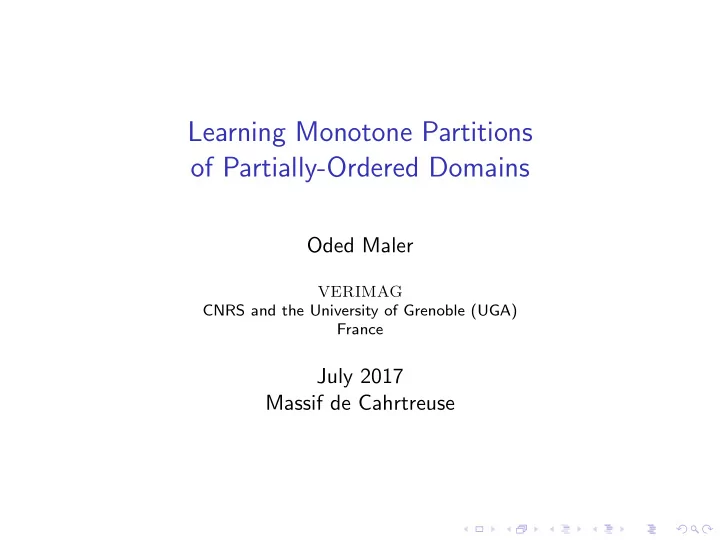

Learning Monotone Partitions of Partially-Ordered Domains Oded Maler VERIMAG CNRS and the University of Grenoble (UGA) France July 2017 Massif de Cahrtreuse
Setting ◮ Let X be a bounded and partially ordered set, say [0 , 1] n ◮ A subset X of X is upward closed if ∀ x , x ′ ∈ X ( x ∈ X ∧ x ′ ≥ x ) → x ′ ∈ X ◮ The complement X = X − X is downward-closed ◮ Together they form a monotone partition M = ( X , X ) of X Y X X Y
Learning the Partition from Queries ◮ We do not have an explicit representation of the boundary ◮ We can pose queries to a membership oracle that can answer whether x ∈ X for any x ◮ Based on this sampling we build an approximation M ′ = ( Y , Y ) of the partition with Y ⊆ X , Y ⊆ X ◮ There is a remaining gap for which we do not know, it is an over-approximation of the partition boundary Y X X Y
Motivation I: Multi-Criteria Optimization ◮ X is the cost space and X are feasible costs (in minimization) ◮ The boundary is the Pareto front of the problem ◮ We ask a solver whether some costs are feasible or not and use the information to construct a approximation of the front (thesis of Julien Legriel) Y X X Y
Motivation II: Parametric Identification ◮ A parameterized family of predicates/constraints { ϕ p } where p is a vector of parameters ◮ Example: u ( t ) is real-valued signal that should stabilize below p 2 within p 1 time: ∃ t < p 1 u ( t ) < p 2 or in STL F [0 , p 1 ] u < p 2 ◮ Find the range of parameters that make ϕ p satisfied by a given u ◮ Under certain assumptions (no parameter appear in opposite sides of inequalities) the set can be made upward closed and the boundary gives the set of tightest parameters x t
Binary Search in One Dimension ◮ In one dimension M = ([0 , z ) , [ z , 1]), for some 0 < z < 1 ◮ The boundary can be found/approximated by binary search x y z x y y
In Higher Dimension ◮ The intersection of the diagonal of the rectangle with the boundary can be found by one-dimensional binary search ◮ Due to monotonicity, the rectangle above y is in X and the one below it is in X ◮ The boundary approximation is refined into the union of incomparable rectangles B 01( y ) B 11( y ) y B 10( y ) B 00( y )
The whole Algorithm ◮ Maintain a list of rectangles whose union contains the boundary ◮ Each time pick one rectangle (the fattest), run binary search on its diagonal and refine it ◮ Problem: number of incomparable rectangles is 2 n − 2 ◮ Theoretical and empirical complexity under investigation
Recommend
More recommend